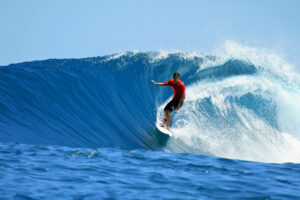Surfing: Dive into the Most Energetic Aquatic Sport
Surfing is one of the most exciting and energetic aquatic sports, captivating enthusiasts with its combination of skill, balance and connection to the ocean. It is known from many movies, TV series and other works of art. This has created a lasting image of the surfer as a tough guy who can do anything! No wonder, surfing has so many fans all over the world.
Ready to Surf?
Surfing traces its origins to the ancient Polynesians, who were the first to ride waves using wooden boards. The sport held significant cultural and spiritual importance, particularly in Hawaii, where it was known as “he’e nalu.” Hawaiian chiefs and commoners alike took to the waves, showcasing their prowess and gaining respect within their communities.
The modern era of surfing began in the early 20th century, largely popularized by Duke Kahanamoku, a Hawaiian Olympic swimmer. Kahanamoku’s exhibitions in places like California and Australia introduced surfing to a broader audience, sparking a global interest. The 1950s and 1960s saw a surfing boom, particularly in the United States and Australia, with the advent of lighter, more maneuverable surfboards and the emergence of a distinct surf culture.
Today, surfing is a globally recognized sport, with millions of participants and a thriving professional circuit. It has become an Olympic sport, debuting at the Tokyo 2020 Games, highlighting its international appeal and competitive nature.
Types of Surfing
Surfing encompasses several styles, each offering unique challenges and thrills:
- Shortboarding: Characterized by shorter, more maneuverable boards, shortboarding is the most common style in competitive surfing. It emphasizes speed, agility, and aerial maneuvers.
- Longboarding: Longboarding involves using longer, more stable boards, allowing for smooth, graceful rides and classic moves like “hanging ten,” where the surfer’s toes hang over the board’s nose.
- Big Wave Surfing: This extreme form of surfing involves riding waves that exceed 20 feet in height. Big wave surfers often use tow-in techniques with jet skis to catch these massive waves.
- Bodyboarding: Also known as boogie boarding, bodyboarding involves riding waves on a smaller, rectangular board while lying prone, offering a different perspective and style.
- Stand-Up Paddleboarding (SUP): SUP surfing combines traditional surfing with paddling, providing a full-body workout and a versatile way to ride waves or explore flat waters.
Popular Locations Among Surfers
Surfing hotspots and events around the world draw enthusiasts and professionals alike, each offering unique conditions and challenges:
- Pipeline, Hawaii: Known for its powerful, barreling waves, Pipeline on Oahu’s North Shore is a legendary surf spot and home to prestigious competitions like the Billabong Pipe Masters.
- Gold Coast, Australia: Famous for its consistent waves and vibrant surf culture, the Gold Coast hosts the annual Quiksilver Pro Gold Coast event.
- Jeffreys Bay, South Africa: Renowned for its long, fast right-hand point breaks, Jeffreys Bay is a top destination for surfers and the site of the Corona Open J-Bay.
Catch the Wave!
The appeal of surfing goes beyond the sport itself, embracing a rich culture that includes music, fashion and a deep respect for the ocean. Surf festivals, surf schools and vibrant beach communities celebrate this unique lifestyle, fostering a sense of camaraderie and adventure.
Thus, surfing’s dynamic history, variety of styles and global reach make it one of the most popular water sports. Become part of the exciting world of surfing and experience the drive and energy of the waves forever!
